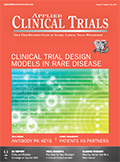Policy and Practice Come Together on EU Vaccine Thrust
Applied Clinical Trials
Peter O’Donnell explores the convergence of policy and science in new vaccine R&D pursuits in Europe.
It’s only a matter of a few weeks ago that the European Medicines Agency (EMA) released a revised guideline on the clinical evaluation of vaccines. This wasn’t the result of EMA prescience that a new outbreak of Ebola fever in the Democratic Republic of Congo in mid-May would concentrate attention yet again on the world’s lack of adequate vaccines. It was triggered by more scientific concerns. But a convergence of pressures-both policy-driven and practical-has imparted renewed urgency to the European Union’s bid to up its game on effective immunization.
First, the draft of the updated guideline (https://bit.ly/2k6B1vk)-which everyone has an opportunity to comment on until the end of October. This “introduces additional safeguards for European Union citizens and ensures that the evaluation is in line with the most up-to-date scientific knowledge and technological developments,” says EMA. And it includes specific considerations for clinical trials in special populations, such as pregnant women or the elderly.
The revised version of the guideline also focuses on strategies for priming and boosting, including heterologous prime-boost in which one type of vaccine is followed by a different one for the same pathogen. In an oblique reference to the Ebola-type scenario, it also covers “the need to develop vaccine for pathogens that may cause future epidemics and for which conducting clinical trials outside of outbreaks might be problematic.”
It is a response to innovations that raise issues for clinical development programs, such as vaccines that include antigenic substances from multiple pathogens or from multiple subtypes of a single pathogen, or the conduct of efficacy trials or identification of immune correlates of protection. It also includes a discussion of factors to consider when planning and interpreting the results of comparative immunogenicity trials-such as the severity, mortality, or risk of permanent sequelae of the infectious disease to be prevented.
It looks at the robustness of the assays to determine the immune response when selecting non-inferiority margins and assessing the clinical impact of failing to meet pre-defined criteria. And in trials that compare candidate and licensed vaccines containing antigens from different numbers of subtypes of the same organism, it comments on interpretation of immune responses to non-shared subtypes.
But EMA’s essentially scientific focus fits conveniently within the broader context of EU policy, which has itself been in rapid evolution recently. In April, the EU unveiled a new draft strategy for member states to cooperate on vaccination, in which the industrial and research aspects of vaccines feature prominently. EU health ministers are to examine the recommended approach later this year with a view to giving it formal status. And the EU will set up a new joint project on vaccination among EU member states this autumn.
Noting that EU citizens are at risk in the face of epidemics because “production capacities in the EU remain limited,” the strategy urges efforts to be made “jointly with stakeholders and industry, improving EU manufacturing capacity and ensuring continuity of supply.” Among the wider challenges related to R&D, the text recognizes the difficulties of developing new innovative vaccines, and highlights the “complex, costly, and risky” improvement of existing vaccines to improve the safety profile, or adapt to different ages, risk groups, or pathogens.
To move R&D forward requires “substantial financial investment and expertise,” it says, recommending the creation of “innovative partnerships and platforms, high-level expertise, and stronger interlinks between disciplines and sectors.” National governments should “increase support to vaccine research and innovation,” and the efficiency of EU and national vaccine R&D funding should be raised, it argued. This should be promoted through new partnerships and reinforced research infrastructures, “particularly for clinical trials.” And EMA should be more closely involved in early dialogue with developers, national policymakers and regulators “to support the authorization of innovative vaccines, including for emerging health threats.”
It isn’t just at EU level that the attention is focused on collaboration. The World Health Organization’s (WHO) annual assembly was set to debate last month on how to address the global shortage of medicines and vaccines, against the background of a promise from the WHO secretariat to “work in support of greater consensus among member states on establishing effective policies on access to medicines, vaccines, and health products.” This is in fulfilment of WHO’s work toward achieving universal healthcare, in line with the targets of the United Nations’ sustainable development goals that notably include “access to safe, effective, quality, and affordable essential medicines and vaccines for all.”
But the challenges are not just scientific or technical or even logistic. There is plenty of evidence of difficulties posed by growing skepticism over the merits of vaccination. Outbreaks of measles-even resulting in deaths-have occurred recently in pockets across Europe where vaccine hesitancy among the local population has led to sharp drops in immunization. More than 14,000 people contracted measles in the EU in 2017-more than three times the level of 2016. Fifty-seven deaths due to measles have been reported since 2016.
The European health commissioner, Vytenis Andriukaitis, himself a physician, has been a passionate opponent of this trend. “It is unacceptable that children are still dying of measles in the European Union,” he said recently. It was at his insistence that the new EU strategy on vaccination emphasizes the need to tackle vaccine hesitancy and to increase vaccination uptake.
Exploring the reasons for the trend, Andriukaitis remarked: “Across Europe, more and more people are avoiding vaccination. Why? Well, misinformation by vaccine deniers, the rapid spread of fake news, public distrust, and the fears of possible side effects all play a role.” And misinformation is available in abundance, in the EU and elsewhere.
Peter O'Donnell is a freelance journalist who specializes in European health affairs and is based in Brussels, Belgium
